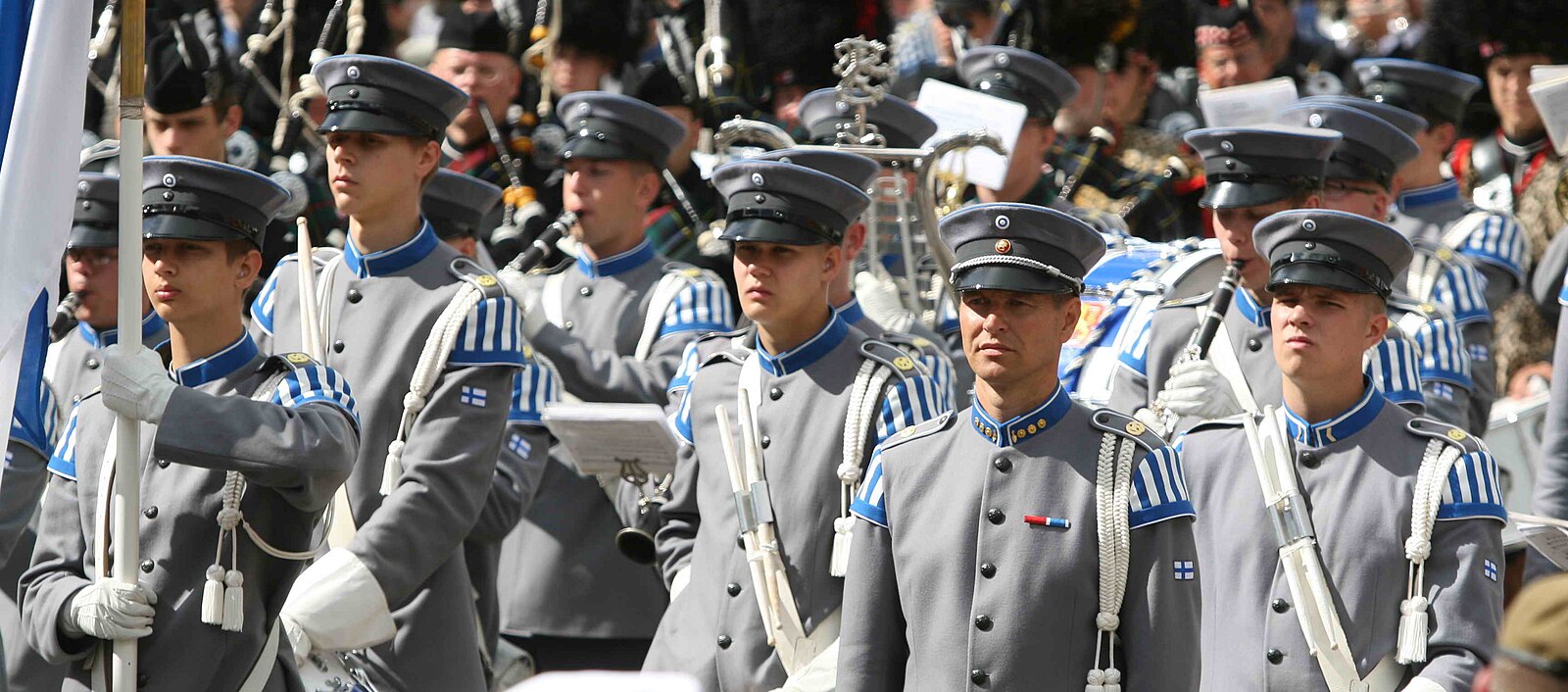Lessons in Finland’s Conscription Model

Finland is a country in Northern Europe that has excelled in both quality of life and military capability. Sharing one of the largest borders with a consistently hostile neighbor in Russia, Helsinki’s quality of life could not have been achieved without citizens becoming confident in the ability of their military to defend a peaceful yet contingently ready, healthy life in Europe.
The Finnish Defense Forces (FDF) are one of the most capable militaries on Earth. They are highly proficient in forest warfare, defensive maneuvers, reserve reaction time, and conscript motivation. With the largest reserve army in Europe, prepared for all contingencies on the continent, Finland exemplifies the art of compulsory military service.
Finnish Conscription
Finland’s conscription doctrine allows for key requirements and enhancements of the country’s land, naval, and air forces. According to the Finnish constitution, every military-aged male between 18 and 60 is liable for compulsory service, and women can enlist voluntarily. Aside from several years of military duty, Finnish citizens can also complete civil service in lieu of any disqualification from conscription.
Starting at 18, all males will go through the call-up system, where a physical will determine if they are eligible for peacetime military service. Those who are ineligible will take part in various forms of civil service, while the call-ups will be given starting dates for boot camp. If one has a special request to attend to, Helsinki can provide deferments for a certain period until said male begins service.
According to the Puolustusvoimat website, depending on billets and specialization of duty, time of service can range from 165 to 255 days or nearly a full year (347 days). Regular conscripts will conduct the 165 days of duty, support services complete the 255 days, and those who wish to be non-commissioned officers (NCOs) or officers finish the 347 days, with options for furthering their careers in the Finnish Defense Forces.
Regarding female voluntary service, over 1,448 applied for the 2025 calendar year, which has continued to increase in popularity since intergender embedding in 1995. According to the Intti Finland conscription overview website, over 14,000 women were trained and served in either the Finnish Defense Forces or the Border Guards adjacent to Russia.
Furthermore, the Finnish Defense Forces and Border Guards provide a guide to prepare future conscripts for military service. This year’s 2025 handbook, ‘Conscript 2025,’ gives a full overview of service, what is expected of each recruit, and what each Finnish civilian can do to prepare for their call-up.
Peacetime, Wartime, and Reserves Overview
After finishing their initial 165, 255, or 347 days of conscription, Finnish men will be placed in the auxiliary reserves until the age of 50. At the same time, NCOs and officers will remain in the system until 60. Throughout the reserve period, over 200 days of muscle memory training, rifles, and other exercises are required to keep reserves in a state of proficiency in case of sudden war, where they may need to be called back to active duty.
Currently, Helsinki has approximately 22,000-24,000 active-duty military personnel between the land forces, navy, and Air Force, who are full-time careerists. However, the FDF can call up 280,000 troops if needed during wartime mobilization. Furthermore, Finland can muster 870,000 fully trained citizens for its reserves—overall, having 1.7 fully trained personnel in a small population size of 5.6 million.
Russia’s continued aggression in Ukraine and its neighbors is making Finland recalibrate its defense, as Helsinki shares the largest border with Russia among NATO members. Helsinki’s Ministry of Defense (MOD) is looking to bolster the Finnish Border Guards, especially as Russia uses hybrid warfare tactics, such as pushing migrants towards Finland to try to destabilize the country.
Capabilities of the Finnish Defense Forces
Aside from a competent military that can muster its reserves, Finland currently has one of the most capable armed forces on the European continent and overall, one of the most war-ready militaries in the NATO alliance. The Finnish Defense Forces presently comprise a wide array of logistics, such as 90 Leopard 2A4 tanks, 200 infantry fighting vehicles, close to 400 armored (tracked) personnel carriers, and one of the largest artillery stockpiles in all of NATO.
Finland’s artillery stockpiles include over 100 multiple rocket launchers (MRLs), 700 mortars, and 700 howitzers. The FDF is doubling its ongoing artillery production with domestic production, which currently outpaces other large European countries such as Germany and Poland.
Finland also has one of the most capable Air Forces on the continent, with 54 F/A-18C Hornets and numerous BAE Hawks. In 2026, the Finnish Air Force will receive a major upgrade as Lockheed Martin will export 64 units of the F-35 Lightning II, which will give Helsinki some of the strongest airpower in Europe.
Alongside Sweden, Norway, and Denmark, the Joint Nordic Air Command not only enhances Finnish and Nordic defense but also furthers cohesion in Northern Europe and coordination for air superiority. Concurrently, the Joint Nordic Air Command is a valuable deterrence to Russian aggression and freedom of movement, and the bloc produces valuable defensive measures in NATO.
Comparisons of Other Countries with Compulsory Service
In the European continent, Finland, along with Cyprus, Switzerland, Norway, Greece, Austria, Sweden, Lithuania, Latvia, Estonia, and Denmark all have compulsory military service with Germany having a limited degree of the conscription doctrine previously and in the future in lieu of rising threats. Finland, Greece, Estonia, Lithuania, Denmark, and Norway differentiate from the others as these countries have not only consistently prepared for looming war with conscription, but also are amongst the highest spenders in NATO GDP-wise, always reaching the 2% threshold with plans to increase defense spending.
Finland differentiates from most other European militaries with compulsory service with not only their conscription model but also making sure there is a continuous stream of combat ready troops. Amidst European remilitarization efforts, new weapons systems require new personnel to work these systems, as seen with Poland, which may struggle with professional soldiers during their military buildup. Finland currently adapts its military to fit the FDF size and capabilities, ensuring the general public maintains its proficiency.
Noted in a July 2024 report by the Carnegie Endowment for International Peace, conscription puts a heavy burden on a country’s economy, which could give major conundrums for other countries to enact compulsory service due to a wide array of factors. A consistent stream of instructors, logistics, positive economic outlooks, and government transparency are all needed to enact conscription, which Finland exemplifies.
Transforming itself from one of the world’s highest suicide rates with an economy in major recession, Helsinki pulled itself into a strong social democracy with a constant stream of income to supplement conscription. Furthermore, Finland participates in global combat missions, as seen in Afghanistan, Iraq, and Mali, as well as United Nations Peacekeeping operations in Lebanon, Kosovo, Somalia, and others. Various peacekeeping and combat support operations allow the FDF to enhance its military capabilities in all sectors of global conflicts.
Contrasting with other militaries around the world that have compulsory service, Finnish conscripts are trained in some of the highest levels of professionalism, and overall military standards to mitigate war crimes and human rights violations, in the European Union. Enforcing the legality of rules of law and professionalism, the conscripts of the Finnish Defense Forces are rarely intertwined in war crimes probes and accusations during any of the modern deployments and peacekeeping missions. This is something other conscription models struggle to mitigate.
The Finnish Defense Forces’ conscripts overall display the values of discipline, proficiency, and sustainability that many compulsory service models lack. With a model template for conscription, Finland exemplifies the mandatory civil service doctrine.







